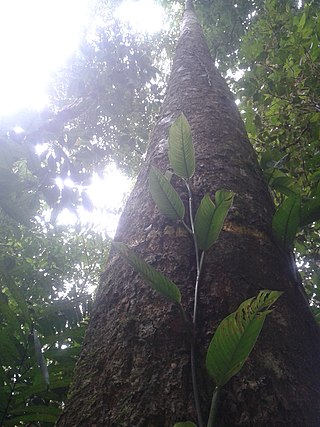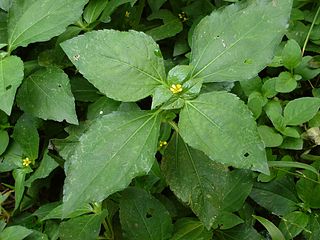Acanthospermum humile is a species of plants in the family Asteraceae. It is native to the West Indies but naturalized in parts of South America, Central America, and North America.
Oblivia is a genus of flowering plant in the tribe Heliantheae within the family Asteraceae.

Pleodendron is a genus of plants in family Canellaceae described as a genus in 1899.
Critoniadelphus is a genus of flowering plants in the family Asteraceae.
Trigonospermum is a genus of Mesoamerican plants in the family Asteraceae.

Gymnosperma is a genus of North American flowering plants in the family Asteraceae.
Westoniella is a genus of Costa Rican shrubs in the tribe Astereae within the family Asteraceae.
Wamalchitamia is a genus of Mesoamerican flowering plants in the family Asteraceae.
Spiracantha is a genus of flowering plants in the tribe Vernonieae within the family Asteraceae.

Synedrella is a genus of flowering plants in the family Asteraceae.

Rumfordia is a genus of Mesoamerican plants in the tribe Millerieae within the family Asteraceae.
Philactis is a genus of Mexican plants in the tribe Heliantheae within the family Asteraceae.

Fernaldia is a genus of flowering plants in the family Apocynaceae, first described as a genus in 1932. It is native to Mexico and Central America.
Arracacia filipes is a plant species native to the Mexican State of Durango. It grows in moist, shaded areas in forests and canyons at elevations of 2,000–2,700 m (6,600–8,900 ft).
Arracacia macvaughii is a plant species native to the Mexican State of Querétaro. It is known only from the type locale, in a fir forest at an elevation of approximately 3100 m.

Ardisia escallonioides, the Island marlberry, is a plant species native to the West Indies and neighboring areas. It has been reported from Barbados, Bermuda, the Dominican Republic, Cuba, Mexico, Belize, Guatemala and Florida.
Laubertia, a genus of plants in the family Apocynaceae, was first described 1844. They are native to Mexico, Central America, and South America.
Laxoplumeria is a genus of plants in the family Apocynaceae, first described as a genus in 1947. They are native to Panama and South America.
Rubus liebmannii is a Mesoamerican species of brambles in the rose family. It grows in southern Mexico and Central America.
Rubus vulcanicola is an uncommon Central American species of brambles in the rose family. It has been found only in Panamá and Costa Rica. The species was initially discovered on the sides of Volcán Poas in Costa Rica.





